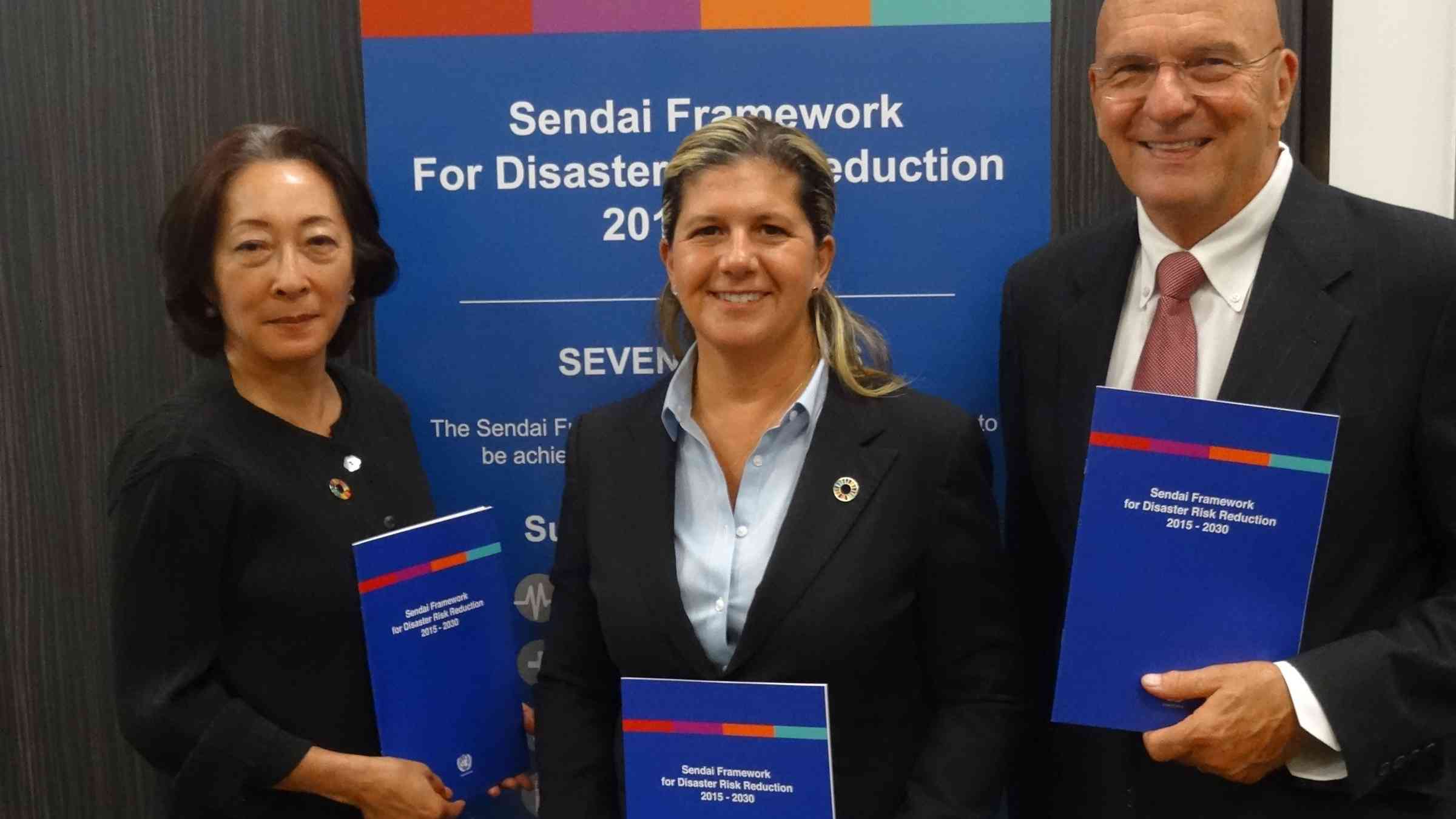Push for more disaster-resilient buildings kicks off with new scorecard

ARISE co-chair and UNDRR chief, Mami Mizutori, ARISE vice-chair, Martha Herrera González, ARISE co-chair, Dale Sands
GENEVA, 30 January 2020 – Destruction of buildings is behind much of the death, injury and economic loss incurred in disaster events, according to a new initiative launched today to motivate the owners and operators of industrial and commercial buildings to improve how they anticipate and manage disaster risk.
“Major disaster events have doubled over the last forty years and natural hazard impact is exacerbated when infrastructure fails. This is most obvious in earthquakes and tsunamis but is also the case in floods and storms. The failure to factor disaster resilience into construction and maintenance of buildings has to be addressed as urbanization progresses at lightning speed around the globe,” said Mami Mizutori, the UN Secretary-General’s Special Representative for Disaster Risk Reduction.
Ms. Mizutori was speaking today on the release of a Disaster Resilience Scorecard for Industrial and Commercial Buildings, developed by ARISE, the Private Sector Alliance for Disaster Resilient Societies - a global network led by the UN Office for Disaster Risk Reduction (UNDRR). ARISE members closely involved in its development include the Institute for Building Technology and Safety, US Green Building Council, Jacobs Engineering, Global Infrastructure Basel, the architecture firm SOM, Jones Lang Lasalle and others.
“The main goal of the scorecard is to provoke thought and action about the disaster resilience of buildings, particularly those located in seismic zones, exposed coastal settings or on flood plains,” said Dale Sands, the co-chair of ARISE.
The ARISE Building Scorecard is structured around the “Ten Essentials for Disaster Risk Reduction” which promote risk governance and have helped to attract over 4,000 cities and towns to join UNDRR’s Making Cities Resilient Campaign.
“The scorecard goes beyond assessing the structural resilience of the building. The building and the city in which it is located share the same risks and a building’s exposure to disaster will be affected by policy and decisions taken by the local government or municipal authorities, “Mr. Sands said.
In addition to highlighting any shortcomings with the disaster preparedness of the building and the community dependent on it, the ARISE Building Scorecard seeks to highlight issues beyond the immediate control of the building owner or management such as road access, water and energy supplies – to provide building owners and managers with their “resilience agendas” for when they hold discussions with the city-planners and investors.
The ARISE Building Scorecard package now available comprises a Summary Scorecard, containing 33 assessments, which can be used to support exploratory workshops with stakeholders including building tenants, community representatives, city planners, emergency managers and representatives of the owner or manager.
There is then a Detailed Scorecard, containing 120 assessments to support in-depth investigation of the resilience of major buildings or facilities. This is supported by a separate cross-tabulation with relevant industry standards.
Lastly, there is an action guide listing possible follow-up actions once the Building Scorecard results have been tabulated.
“With existing buildings, improving resilience may require retrofitting existing structures and processes but ‘build to last’ should be the objective and to that extent the Building Scorecard is also relevant to developers, architects and design engineers,” said Peter Williams, lead author for the Scorecard and formerly of IBM.
"We hope that by creating a straightforward platform for building owners and managers to proactively address the growing risk of natural hazards, we serve real estate investors, developers, architects, engineers, government professionals and community leaders who are increasingly concerned about the physical impact of climate change on their built assets," noted Scorecard co-developer Joyce Coffee, president of Climate Resilience Consulting and former lead of the Global Adaptation Index.
PRIVATE SECTOR ENDORSEMENTS FOR ARISE BUILDING SCORECARD
“The development of the ARISE Scorecard for owners and operators of industrial and commercial real estate provides an excellent applied basis for assessing the resilience of these essential buildings within the economic development and growth of urban areas, regions and countries. Overall, the Scorecard is an excellent framework for analysis of building resilience.”
- Prof. William Hynes, Managing Director, Future Analytics Consulting.
“The Scorecard is an important resource for city leaders and decision makers to plan and prepare for climate change-related disasters. We are proud to be part of the team that produced this valuable tool to identify and prioritize efforts to tackle one of the largest challenges ever to face mankind.”
- Dr. Thomas Tang, Sustainability Advisor, City University of Hong Kong
“As extreme weather from climate change and growing urbanization are making cities more vulnerable to damage caused by natural hazards, Jacobs Solutions is partnering with leading organizations such as UNDRR to deliver innovative solutions that help solve some of humanity’s most critical problems. This scorecard is an example of what comes from successful, multi-disciplinary collaboration.”
- Monte Wilson, Global Director of the Built Environment, Jacobs Solutions
Also featured on
Is this page useful?
Yes No Report an issue on this pageThank you. If you have 2 minutes, we would benefit from additional feedback (link opens in a new window).